“Listen, SCOOP – crime reports are coming in from all over the city and I’m starting to get worried…”
It’s not every year that a new attraction debuts, stealing headlines, entirely rewriting the course of the theme park industry and redefining what a ride can do… And on the rare occasions that has happened, it’s typically not outside of Disney Parks. And yet, even for fans of Disney Imagineering, there’s at least one Universal attraction that’s simply astounding; inspiring; electrifying; amazing.
Here at Park Lore, our well-loved library of Lost Legends contains the age-old classics of yesteryear, using your comments and memories to save their stories for a new generation. But what about the living legends we can experience today? The incredible wonders that surround us? Instead of looking back, sometimes we merely need to look up to see what’s right in front of us – Modern Marvels with equally complex and spectacular stories.

And when it comes to industry-changing rides, we can only be talking about The Amazing Adventures of Spider-Man, the web-slinging and groundbreaking dark ride that debuted alongside Universal’s Islands of Adventure – “the most technologically advanced theme park in the world” – in 1999.
So today, we’ll get the inside scoop on this brilliant attraction, see the almost-unbelievable story of the completely different hero who almost starred in it, and step into our own SCOOP to face the Sinister Syndicate with our friendly, neighborhood web-slinger. But with Spider-Man nearby, trouble can’t be far away… “And you know what trouble means: headlines! National coverage! So don’t screw this up! I mean, uh… good luck.”
And before we head off, remember that you can unlock rare concept art and audio streams in this story, access over 100 Extra Features, and recieve an annual Membership card and postcard art set in the mail by supporting this clickbait-free, in-depth, ad-free theme park storytelling site for as little as $2 / month! Become a Park Lore Member to join the story! Until then, let’s start at the beginning…
Disney vs. Universal
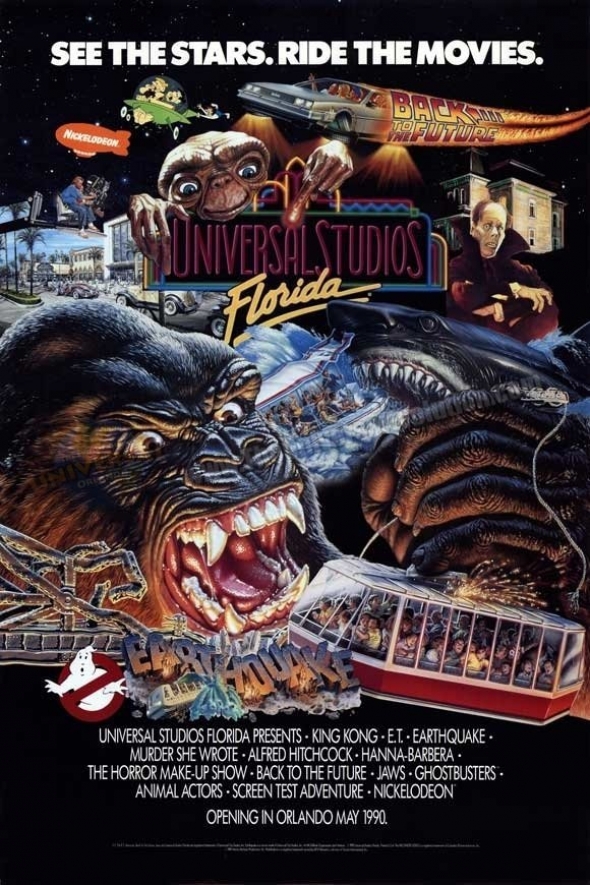
Despite larger-than-life mythology that makes it sound like a centuries-old battle, the rivalry between Disney and Universal (and namely their Parks & Resorts divisions) wasn’t really kicked into high gear until the early-1980s. That’s when MCA Inc. – then-parent of Universal – began moving forward with plans for an Orlando-based movie studio theme park… and when Michael Eisner swept into Disney as CEO and rush-ordered a movie park of his own – an unlikely origin story of the era’s back-and-forth battle we told in our Member-exclusive “Ride the Movies” Special Feature.
In part thanks to Disney’s near-self-governance in “Reedy Creek,” the Disney-MGM Studios beat Universal Studios Florida to the red carpet by a full year. Even once both of Orlando’s “movie” theme parks were ready for action, they pretty quickly differentiated themselves from one another. Disney’s park heavily hinged on its “real, working” studio (and the headlining Declassified Disaster: The Backstage Studio Tour), whereas Universal’s park was a disaster waiting to happen… Literally…
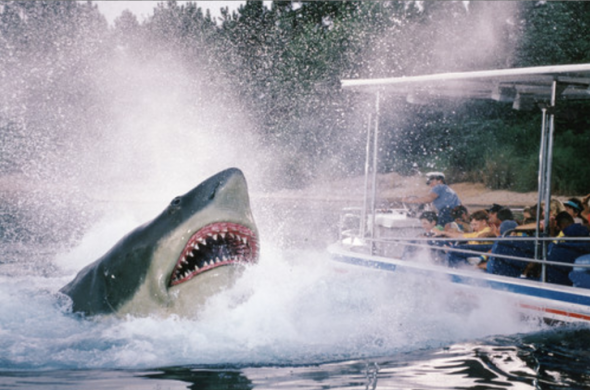
Between killer sharks, giant apes, robots from the future, bullies from the past, and natural disasters, a day at Universal Studios Florida certainly wasn’t for the feint of heart! The origin of Universal’s tried-and-true formula of adapting its Studio Tour scenes from Hollywood into standalone stars in Orlando, the Florida park’s “creature feature” rides made it a touch too trying for families with toddlers. Universal appeared more or less content to tailor its park to families with teens, even if that ensured they’d remain a mere daytrip for just a subset of Walt Disney World vacationers rather than a destination in their own right.
But make no mistake: from the moment Universal Studios Florida was completed, MCA was hard at work “building a better mousetrap.” As early as 1990, plans were coalescing around MCA’s largely-untapped 400-acre site in Orlando that would transform the single studio park into a multi-day resort complex. Of course, “Project X” would include an East Coast version of the CityWalk concept under development back in Hollywood, a smattering of “on-site” hotels, and the benefit of master-planned transportation and guest flow.
But as the centerpiece of its all-at-once growth spurt, Universal Studios Florida would be joined by a second theme park.
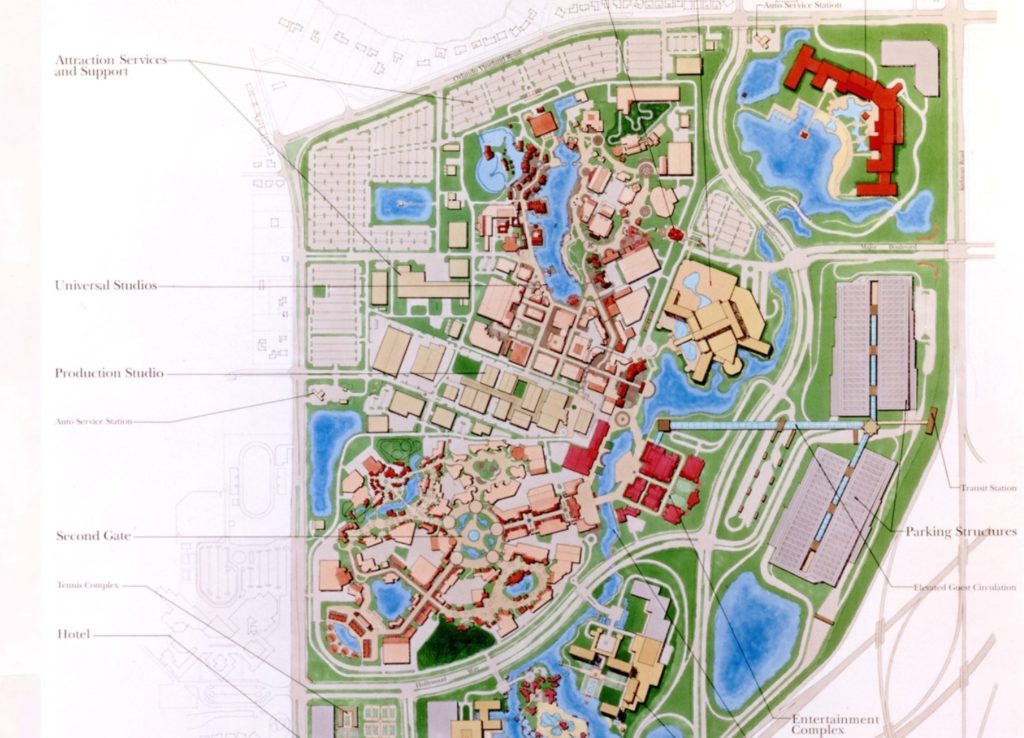
As development on “Project X” began, MCA turned to a preeminent figure within the era’s themed entertainment industry: Gary Goddard. As head of the Landmark Entertainment Group, Goddard was no stranger to the halls of Universal Creative. In fact, in the early ’90s, Goddard and company were already hard at work developing Universal’s time-traveling Lost Legend: T2-3D and Jurassic Park: The Ride in Hollywood.
A go-to source for Universal Parks design and fabrication in the early days of the Florida park, it’s really no surprise that Goddard and Landmark were called upon to develop attraction concepts for Universal’s proposed second gate. What is surprising is what they were tasked with creating for Universal’s second gate. A direct play at Disney’s demographic, the second gate at Universal would be based on cartoons.
Cartoon World
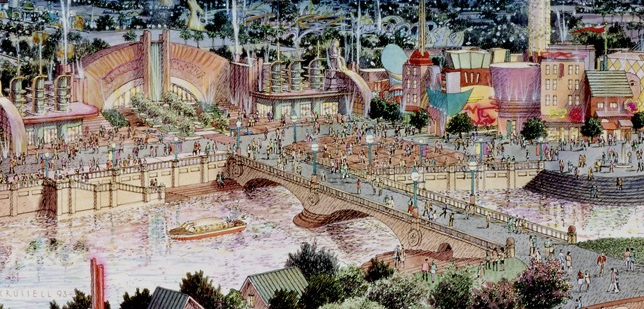
If “Project X” had gone forwarded as initially envisioned, Universal Studios Florida would’ve been joined by a new neighbor: a second park called Cartoon World. An incredible collection of attractions was devised by the Goddard Group (among others) for this spectacular second gate, and luckily for industry enthusiasts, much of it is available thanks to the reporting of Josh Young at Theme Park University and Alicia Stella at ParkStop.
What we know is that Universal would reach beyond its own intellectual property in order to accumulate enough stories to populate an entire park with timeless characters that could rival Disney’s classic collection. Entered via the Loading Dock of a “Comic Strip Factory” (where we’d see our favorite toons clocking-in to start the day) and an ensuing “Main Street” packed with anthropomorphic Jay Ward character environments (from Rocky and Bullwinkle, George of the Jungle, and Mr. Peabody and Sherman), this unique park would’ve placed themed cartoon lands in a Magic Kingdom style layout.

And unlike the Studios park next door, Cartoon World wouldn’t be tied to hot properties of the day, necessitating continuous replacements and refreshes. Instead, it would opt out of movies and into stories with lands bringing to life evergreen cartoon characters shared through generations. The Northwest Mining Camp (themed to Jay Ward’s Dudley Do-Right), Popeye’s Island, The World of Seuss, and Warner Bros. Looney Tunes Land would pack the park with beloved sights, sounds, and stories known by all.
Whimsy and wonder were on the menu… except in Cartoon World’s sixth cartoon realm. There, action and adventure would rule over a comic book cityscape of heroes and villains, police sirens, epic encounters, and good and evil. That’s right – MCA planned to license the theme park rights to truth, justice, and the American way: DC Superhero Land.
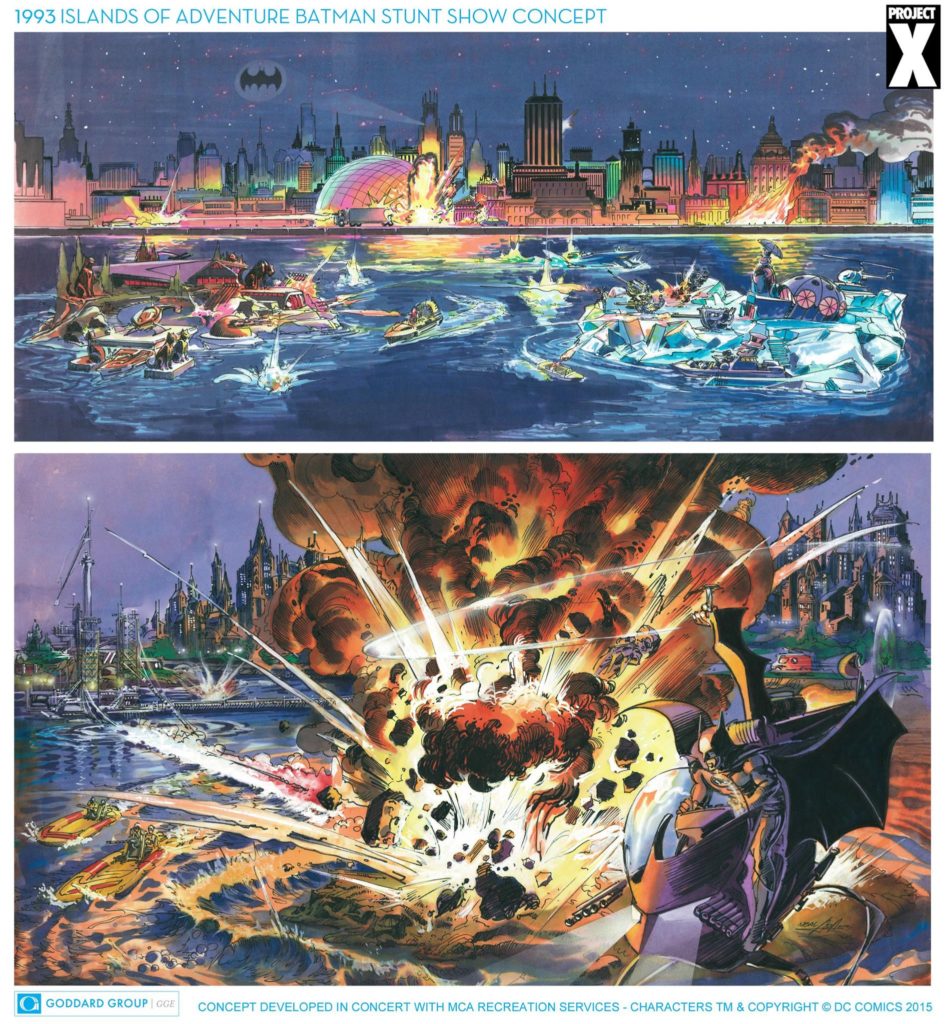
Even before a contract had been signed, MCA’s executives allegedly invited Goddard and others to begin crafting concepts for theme park attractions based on the stories, characters, and worlds of Dr. Seuss, the Looney Tunes, and DC Comics. Their hope was that robust, quality attraction renderings (like a proposed Batman & Robin Action Adventure Spectacular ski-show, above) would actually help sell each IP’s respective rightsholders on quality representation Universal’s new park could offer.
In an interview with Inside Universal, Goddard recalls how he’d always loved DC Comics, and happily got to work on developing his own ideal DC Superhero Land for Cartoon World…

Naturally, he designed the land to be one of extremes: one half of the land, Gotham City, would the “dark side of Superhero Land,” themed to the gothic, gritty, industrial city (closely modeled after the Tim Burton / Michael Keaton films) of Bruce Wayne and his caped crusader alter-ego, Batman.
Goddard’s plans for The Joker’s Madhouse attraction had guests enter into mix of haunted house, carnival, and walkthrough to access a wild mouse style roller coaster / dark ride combination with an elaborate post-show of “twisted” carnival rides for thrill-seekers.

BatWing, meanwhile, would’ve been a suspended twin coaster face-off between Penguin and Batman wherein riders would choose either the Pen-O-Wing track or the Bat Jets track. The inverted coaster would then dart over the streets of DC Superhero Land, racing together and then diverging to burst through showbuildings before “dueling” at key points along the coasters’ tracks.
The other half of the land, Metropolis, would be the “city of light,” themed to the Art Deco architecture of Chicago and New York in the 1930s – home to Superman. It’s here that guests could enter the glimmering glass skyscraper of the Daily Planet and become field reporters aboard a cutting-edge thrill ride.
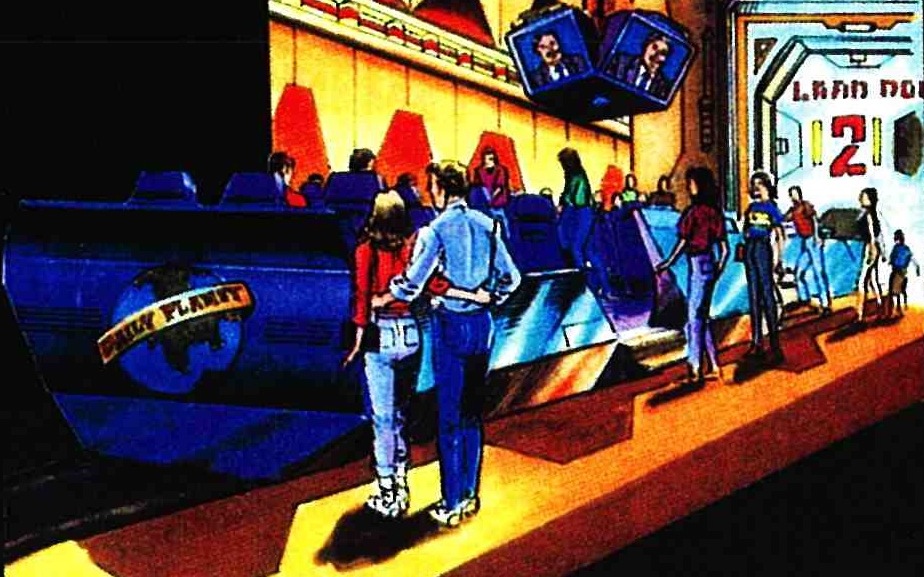
According to our friends at Theme Park University, this cutting-edge ride would’ve seen guests become Daily Planet reporters, boarding 18-person vehicles that would advance into the belly of a “telecopter.” Once inside, wrapped projection screens would make guests feel that they were rising high over Metropolis for a bird’s-eye view of Lex Luthor’s latest supervillain rampage.
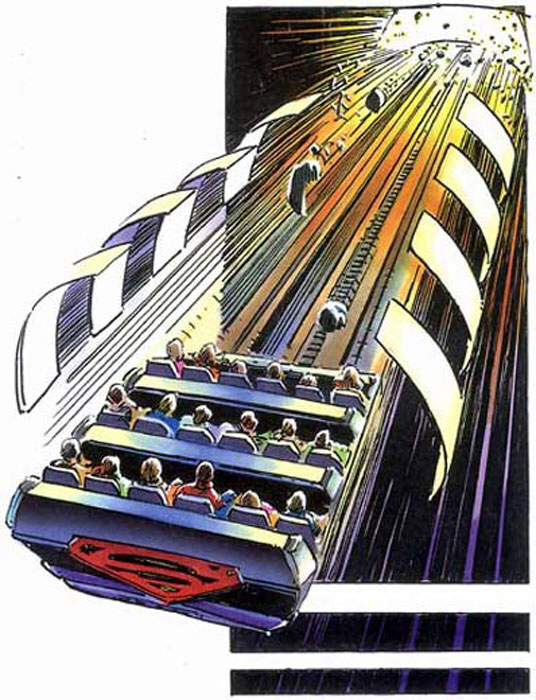
While details are scarce, it’s believed that these 18-passenger vehicles would rock and rumble to the surrounding screens (like a Disney Lost Legend: Star Tours)… with a catch. While simulating each telecopter’s rise and flight over Metropolis, the pod would actually be rising over a hundred feet concealed in a skyscraper of Metropolis. So each ride’s crashing finale would actually lead to a 100-foot drop-tower-style freefall. Without a doubt, this Superman-themed attraction would’ve been a technological highlight of the park… if it had been built…
Negotiations and Mutations
There was only one problem: According to Sam Gennaway’s spectacular, must-read book Universal vs. Disney, Universal had overextended itself in trying to acquire so many external properties and had found itself locked in a head-to-head showdown with Time Warner, who owned the rights to both DC Comics and the Looney Tunes – two-fifths of Universal’s Cartoon World’s core IPs.

Allegedly, it was a battle over royalties. Time Warner wanted 10% of royalties earned from Universal’s new park – a reasonable request given the major role its heroes and cartoons would play in the park’s lineup. MCA Inc. offered only a 6% share. Even when Time Warner was willing to compromise with 8%, MCA wouldn’t budge.
Though Universal’s designers begged for MCA executives to agree to the 8% figure (given how many attraction they’d designed around DC Comics and the Looney Tunes), the negotiations came to an abrupt end… To hear Gary Goddard recount the story to Gennaway, MCA’s Sidney Sheinberg was fed up with the process and told his contact at Time Warner, “We don’t need your [expletive] characters.” And that was that.
Cartoon World was dead on arrival.
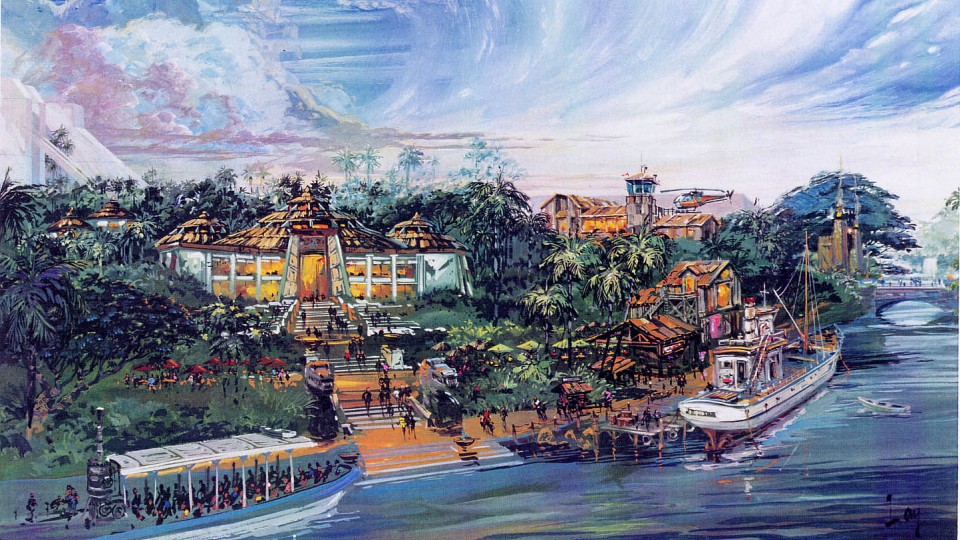
But maybe that’s for the best… The loss of a Warner Bros. partnership forced Universal back to the drawing board with a few holes to fill in the new park’s lineup. And they found inspiration in their own library… At the time, Steven Spielberg was finishing up production on Universal’s Jurassic Park while the Goddard Group put the finishing touches on the Lost Legend: Jurassic Park: The Ride for Universal Studios Hollywood.
Given the stellar expectations for the film and ride, it occured to designers that Jurassic Park could even occupy an entire themed land of its own at a Disney-quality second gate.

With Bugs and Bruce Wayne out and Jurassic Park in, Universal allegedly hired on scores of former Disney Imagineers who had fled Michael Eisner’s cost-cutting in the wake of Disneyland Paris’ abysmal opening. As the story goes, they brought with them concepts Eisner had axed, which Universal was happy to fund. That’s how Port of Entry and an epic forgotten land and Lost Legend: The Lost Continent, found their way into the new park’s designs.

A simple “Cartoon World” no more, the new, rounded-out park gained a new thesis and a new name: Universal Studios Islands of Adventure would transport guests into the epic stories and unforgettable adventures of blockbuster films, favorite cartoons, storybooks, and mythological landscapes…
Port of Entry, Seuss Landing, The Lost Continent, Jurassic Park, Toon Lagoon… And as for that action-oriented, comic-book land?
The concepts Universal Creative had cooked up for the DC superheroes wouldn’t go to waste… Universal had found another comic giant who’d fallen on hard times and was happy to make a deal to be exclusively featured in Universal’s second gate… Read on…


